- Home
- Gary Vaynerchuk
Crush It! Page 5
Crush It! Read online
Page 5
* * *
There’s only one test I can suggest if you want to be absolutely sure that the passion around which you’re building a brand is also a monetizable product. Can you think of at least fifty blog topics that you’re amped to write about it? That’s about the minimum number of posts you’ll need to give yourself enough time to get a feel for the situation.
That said, I’m convinced that if something is your true passion you can find five hundred things—five hundred interesting things—to say about it. Most people talk themselves out of success before they even start. Their passion is stickers, but they think, “There’s no way I can make a hundred grand talking about stickers.” That’s why you’re going to crush it—because you’re the type who’s going to say, “Stickers? Hell, yes, stickers!”
* * *
tell a story
Great content is also all about telling stories, and that’s true even if you’re in retail or B2B or consumer services. If you’re a real-estate agent and your area is Clark, New Jersey, then you should want to tell me everything about Clark that makes it unique. Tell me the story of the town, not just the home you want to sell. Make me care about the place as much as you do. If you’re a doctor, tell me about the interesting cases you saw today. Tell me about the trends you’re seeing, or give me advice or your opinion about flu shots. If your passion is sales, talk to me about why you love it, your favorite persuasive technique, your most interesting clients, and your biggest challenges. Tell me your story, and if you’re good, I’ll come back for more. Then I’ll tell my friends, and they’ll come, and where my friends and I go, the dollars—in the form of ad revenue, sponsorships, and invitations to broaden your platform—will follow. Communicate with me, because whoever is the best communicator will win.
don’t lie to yourself
Do you have any idea how many people introduce themselves to me with, “Hi, I’m going to be the next Oprah”? I’m all about being confident, and I respect anyone who’s got big ambition. But let’s face it, not everyone is going to be Oprah. Everyone has the ability to achieve great self-awareness, but we all occasionally lie to ourselves. Some of us, however, lie to ourselves more than others.
When you start thinking about your livelihood and your passion and the content you want to create, may I suggest looking in the mirror and having the following conversation with yourself?
“Is technology (or candy or marketing or soccer) my ultimate passion?
“Yes.
“Okay. Am I good enough to be the best blogger about tech (or candy or marketing or soccer) in the world?
“Uh…”
If you cannot answer both of those questions—Am I sure my passion is what I think it is, and Can I talk about it better than anyone else?—with an emphatic “Yes!” you are not going to win. You’re not even going to come in fifth, or ninth, or twelfth, which can also be perfectly respectable, profitable positions.
But didn’t I say that anyone who creates a blog around his passion can monetize? I did. But a lot of people are good at deluding themselves. And if you go into this deluding yourself, you’re not going to make the money and you’re not going to be happy and you’re going to be just another boring blog on the Internet.
* * *
You can monetize any passion, but the level at which you can monetize will be affected by the size of your niche and whether you are able to differentiate yourself enough from the other players in it. There are a lot of pockets out there today, however, that can sustain a nice forty-to-seventy-five-thousand-dollar-a-year business.
* * *
choose your medium carefully
We’ve all watched and read and listened to boring blogs. Most of them out there, in fact, are really boring. Is it because the star doesn’t know what he’s talking about? No—he’s on message, he’s relevant, he’s informative. The problem isn’t that he doesn’t know what he’s talking about, it’s that he’s talking about it at all. He probably should be talking about something else, something that makes him shine, that gets him excited, that allows his personality and his passion to burst through your monitor and demand that you pay attention no matter whether he’s an introvert or an extrovert.
A lot of people add these blogs to their websites for visual interest and to offer a different way for their audience to get information, and that’s fine. But adding video or audio elements just for the sake of adding them isn’t going to send your brand and business to the moon. The only way these tools work is if you’re using them for the right job. Even the dullest introvert has pizzazz when talking about something he is passionate about, and when he’s using the right medium to talk about it. If you watch an engineer talking about engineering, and it’s boring, one of three problems is in play: he’s talking about the wrong topic, he’s using the wrong medium, or both. If I spent an hour with him, maybe we’d discover that his medium is writing, and his passion is baseball. Get him writing about baseball, and I guarantee he’ll get better feedback and financial results than he ever had when talking about engineering.
There are people who belong in front of a camera, there are people who belong in print, and there are people who belong on the air. These are the extraordinary people. The ordinary ones, the ones like the vast majority of businesspeople and entrepreneurs out there, don’t have the showman DNA. That doesn’t mean they won’t succeed, as long as they are realistic about what success is going to look like. The extraordinary people will makes millions of dollars and the ordinary Joes will earn more in the midfive-figure range. Is that disappointing? Think of it this way: Oprah, who is without a doubt extraordinary, built her brand using the right medium and the right topic, and she made billions, and the massive majority made zero. Today, everybody else can make $40,000 to a million, so long as they can nail the correct combination of their medium and passion. In most of the country, earning midfive figures means you’re living pretty well, often exactly as well as you would were you schlepping into someone else’s office every day. Now though, you’re earning the same money talking about something you are crazy about. It’s a good deal. Take it.
Know yourself. Choose the right medium, choose the right topic, create awesome content, and you can make a lot of money being happy.
the lure and the lasso
You’re going to work your content in two ways. The first is as a lure, creating it, posting it, and allowing people to come to you as they discover it. The second is to use it as a lasso through comments on other people’s content that relates to yours, inserting yourself into existing conversations and actively creating reasons for your audience to come to you. Of course, you have to give people a place to find your killer content, so let’s go there next.
six
choose your platform
So you’ve got a killer product or service and content, now you’re going to deliver your message via a blog. In the online world, you’ve got three formats to choose from, though some people might do a combination: video, audio, or written word.
* * *
There is a ton of information already out there detailing the minutiae of how to use all of these platforms. Rather than waste your time here repeating what’s already been said, I’ve recommended in this chapter some of the best resources available. I’d much rather make sure you understand the global implications of these platforms. That said, the next three chapters offer general descriptions and explanations of all the building blocks you’ll need to build a successful business through social media. In chapter 10 you’ll find an in-depth example of personal brand building that incorporates just about every concept and technique we discuss.
* * *
This step in building your business is once again all about working with your DNA. To my mind the most effective content medium is video, and that’s the one I prefer to focus on. It’s just easier to grab people’s attention and draw them in, especially a public who reads less and less. I also think letting people see you is a major plus when you’re trying
to sell a personal brand. Don’t think any subject is off-limits for a video blog. If your passion is sales, do a show about sales. Can you imagine Sam the Salesman who picks a new selling opportunity every day? On Monday he sells flowers, on Tuesday he heads to the flea market, and so on throughout the week. Or maybe he takes a new job and chronicles his rise to salesman of the year. If you’re an accountant, you can still put out a video. I sure as hell don’t want to read accounting materials, but I’d watch a video if you were good enough to make something like balance sheets or operating profit interesting and you infused your show with personality and everything that makes you unique. Do that and your audience will find you. I guarantee it.
I use video because I love to talk and I’ve got a big personality and that medium is the most fun for me. But again, do not compromise your DNA. If you’re self-conscious in front of a camera but have loads of personality plus a compelling voice, don’t force yourself to do a video blog, do an audio podcast. Think about it; it’s not just car buffs who listen to Car Talk’s Click and Clack, who have a weekly radio show but also a podcast on NPR. They’re so funny, charismatic, and knowledgeable they could talk in those Boston accents about nothing but carburetors all day long and keep people’s attention. Do the same thing for photography, or coffee, or soap, or scuba diving. If you have a squeaky voice or you’re shy but a brilliant writer, obviously a written blog is the perfect medium for you. By now there are plenty of success stories about people who monetized their awesome blogs. Why can’t that be you?
There are other advantages to blogs. They increase the ability for people to find you through Internet searches because their content changes and expands daily. Not so with a website. Publishing a webpage can be very labor intensive and even require learning new software, but a parrot can put up a blog page. It’s easy, it’s customizable, and it’s free. What more do you want?
Even if you already have an ecommerce website or your focus is B2B, you need to start a blog (though once you see how simple it is to do, you may ditch your website altogether). Think of it this way: your website is for communicating logistics and facilitating sales; your blog is for communicating the essence of your brand. It allows you to expand on your topic in ways that a static website simply can’t. For example, if you are a software company, your website will explain what products and services you provide, but on your audio podcast you can discuss your thoughts on current software trends, or you can interview company leaders who use your products, and even some who don’t, to explore the topic more fully. Giving people interested in software the opportunity to get to know you as a living, thinking, interesting human being who happens to know everything they want to know about software will make them that much more likely to want to do business with you.
Your blog will be your main home, your central location with a no-exceptions open-door policy where anyone can find you. It also serves as storage for all the content you will create, essentially building an archive where people can see how you and your business have evolved and expanded. It is the place where you can talk as loud and as long and as often and as in-depth as you want.
To keep people coming to this home, you need to be constantly reaching out and interacting with the online community of people interested in your passion who are also your potential constituents. To do that, you’ll need to step up to one of the many online platforms where you will do the bulk of your marketing and social networking.
the must-haves
In December 2008, I spent $7,500 to offer free shipping codes for Winelibrary.com via three marketing/advertising channels—a perfectly placed billboard on the New Jersey Turnpike, direct mail, and radio. The billboard brought in a hundred and seventy orders. The radio campaign did about two hundred and forty orders. Through direct mail we got a little over three hundred. I Twittered out—for free—a free shipping code and got seventeen hundred orders in forty-eight hours. What this anecdote should prove to you is that platforms are everything, and that the old ones are softening. If they don’t adjust soon, they will be gone or at best irrelevant. As it is, these traditional platforms should be only used by the biggest of companies who can afford the scale.
Television, newspapers, and radio used to be the global platforms. Through these channels, companies and a few lucky, connected individuals could distribute their content to the world within a few days. Now, though, all of those platforms have been overshadowed by the biggest global platform ever, the Internet. Within this global platform are social marketing subplatforms, and these are the tools you’re going to use to distribute your killer content and your personal brand to the masses, not in days, but in seconds.
The difference between promoting your brand via traditional marketing and advertising mediums and doing it via social networking platforms is like the difference between sending a message by Pony Express and chatting on Instant Messenger. Sure, you could use the former, but there’s a good chance the recipient will have moved on and forgotten about you by the time the message arrives at its destination.
We’re bordering on social network platform overload. There are fifty or sixty platforms that people are currently using to distribute business content, and by the time this book comes out there will be more, but there are only a few major players with which you need to familiarize yourself. Some have funny names, but otherwise they are no different from the hammers and buckets of paint and fax machines and telephones that people have used for generations to build businesses and spread the word about what they have to offer. The rest of this chapter offers an overview of the leading social marketing platforms and the optimal way to use them.
wordpress and tumblr
All other platforms lead to this one—your home, your destination, your blog. Wordpress and Tumblr are the best and most popular blogging platforms currently available. There are others of course—Blogger and especially Six Apart products are good (and there is smoke at Six Apart, so by the time this book comes out they may be in the game)—but these are two that I have used and liked. Wordpress is the established leader with the most users. Its design is a little busy, it requires a few more steps to get your content up and shared, but it’s not difficult to learn. With some practice, in fact, there are some really interesting options available to skilled users, although to my mind there’s no reason to bother becoming that skilled. One of its nicest features is an excellent and easy archive system with a search capability, so people can find anything you’ve ever posted. And Wordpress allows for some sophisticated customization to your page. I’m a big fan of the “themes,” too. These are the design options you get to choose from when you create your page, and I think they’re really elegant.
Tumblr, on the other hand, is a very simply designed site that is supereasy to use. You can post video and photos on Wordpress, but Tumblr directs you to a template designed specifically for the kind of content you wish to create, whether text, photo, link, video, or music. Hit “Create Post” and you’re good to go.
It’s a little known fact, too, that Tumblr is the only blogging platform that will host your domain name for free, which can save you hundreds of dollars a year. What this means is that you can identify yourself as Sallydressdesigner.com (you have to buy your name from GoDaddy.com first) instead of Sallydressdesigner.tumblr.com. You have that option on Wordpress, too—sallydressdesigner.com or Sallydressdesigner.wordpress.com—but if you forgo the company name, you have to pay hosting fees.
Another advantage to Tumblr is the reblog function. On Wordpress you have to write a new post about a story you read in order to tell others about it. When account users see somebody post something that they like on Tumblr, they can hit a button above the story that says “reblog,” which allows them to “tumble” it. With that, they’re using your blog to extend someone else’s story. That is exactly the kind of 2.0 word of mouth you want to inspire in your audience so they will do the same for you.
* * *
E-mail me at [email protected] for deta
ils about the press conference I’m going to have to explain why I’m a fan of Tumblr.
* * *
When using this platform, the most important thing to consider is the user interface of your blog. Consider the “following” buttons as the displays to your storefront—they are what will turn one visit into repeat business.
call-to-action buttons
These incredibly important buttons are all about capture. “Subscribe to Email,” “Friend Me Up,” “Follow Me,” “Become a Fan”—all of these are ways to suggest that your users prolong their interaction with your brand. When you’re working your butt off on your social networks to bring your community into your domain, it’s so that they will click on one or several of these buttons. If you tried getting people to friend you or follow you via Facebook or Twitter, you’d come across as spam. In the top right corner of my blog I now have a button that says, “Buy my book.” Can you imagine how obnoxious I’d look if I sent out tweets every day urging that call to action? Instead, I use the other tools in my toolbox to bring viewers back to my blog, where I knock their socks off with my content, which inspires them to hit the “Buy My Book” call-to-action button and convert a blog visit into a chance to further build my brand and my revenue.
share functions
These are about word of mouth. They are the buttons on your site that make it easy for your viewers to share your content with their social networks—“Stumble Upon,” “Digg,” “Reddit,” “Facebook,” “Email This.” You use them to lead your users to the well, empowering them to quickly and easily distribute your content for you if they find it exciting and interesting.

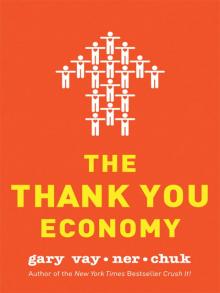 The Thank You Economy
The Thank You Economy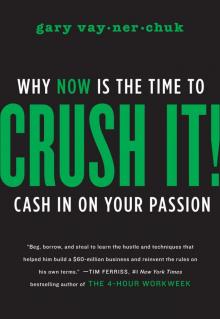 Crush It!
Crush It!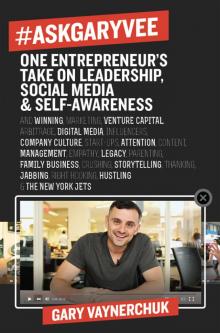 #AskGaryVee
#AskGaryVee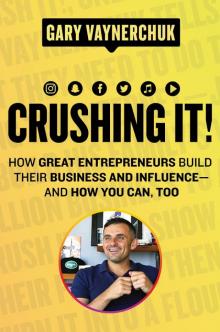 Crushing It! EPB
Crushing It! EPB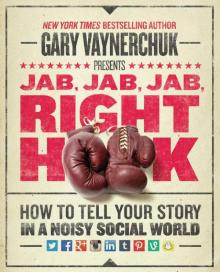 Jab, Jab, Jab, Right Hook
Jab, Jab, Jab, Right Hook